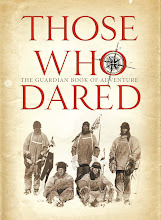With so many media outfits binning their libraries, it's always heartening to come across a company that still sees the value of holding onto their archives, and, most importantly, knowledgeable people who know their way around them.

I recently visited one such collection, the Daily Mail's picture archive which is a treasure trove of prints and negatives from roughly 1907 up until 1997. Housed in a basement near London Bridge, it may be several miles away from the main office but staff can find pictures, scan, and send them back to the picture desk within minutes. Alan Pinnock, the librarian who has worked there since the late 1960s, asked if there was anything interested in. Off the top of my head I, er, suggested mountaineering and so he pulled out a few files from the 1924 and 1933 expeditions to Everest. The latter included some fascinating aerial shots of the mountain.
Quite by chance though, Alan was updating a file on Eileen Healey, a British mountaineer who recently died, aged 89. Healey was part of the 1959 all-female expedition to Cho Oyu, the world's sixth highest peak. This was organised by French climber, Claude Kogan, and a team that included members of the British Ladies Alpine Club, the Pinnacle Club, and three Nepali women. Unfortunately the expedition ended in tragedy with the loss of four climbers, including Kogan – probably due to storm and avalanche at or above Camp 4. Another British climber Countess (Dorothea) Gravina then took over as leader.
Although only an amateur photographer Healey had been invited to use her family cine-camera to record the expedition. After the tragedy the resulting film lay in an attic until, three years ago, it was put into digital format and shown at the 2009 Kendal Mountain Film Festival.
Three years later and Gravina led another all-female expedition, this time to the Jagdula region of Western Nepal. A Daily Mail photographer accompanied them and it was perhaps inevitable that the following shot of cosmetics and a handbag amidst all the climbing paraphanalia would be taken. Judging by its battered state, the print had been used several times.
(Copyright: Daily Mail)
Back in the office a quick search about the expedition brought up an interesting piece about Jo Scarr and Barbara Sparke, two climbers from the team, which goes against the accepted wisdom that low-budget Himalayan expeditions only really started in the mid-1970s.
(Observer, March 18 1962 - Click to enlarge)
Many thanks to the Daily Mail picture library.

 While the world's highest mountain was named after Everest in 1856, the military engineer and geodesist was always rather embarrassed by the honour. The story goes that in 1852, Radhanath Sikhdar who worked for the Grand Trigonometrical Survey of India, discovered what he thought was the highest peak in the world. Several years later this was confirmed and despite it already being called Chomolungma by the Tibetans and Sagarmatha by the Nepalese (words not deemed "intelligible to civilised man"), the British decided to name it after Colonel George Everest, head of the survey.
While the world's highest mountain was named after Everest in 1856, the military engineer and geodesist was always rather embarrassed by the honour. The story goes that in 1852, Radhanath Sikhdar who worked for the Grand Trigonometrical Survey of India, discovered what he thought was the highest peak in the world. Several years later this was confirmed and despite it already being called Chomolungma by the Tibetans and Sagarmatha by the Nepalese (words not deemed "intelligible to civilised man"), the British decided to name it after Colonel George Everest, head of the survey. 































